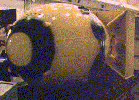|
|
|
|
|
|
on its 50th Anniversary



|
by Gregory WalkerIt was sobering to stand in the room where the plutonium "pit" was assembled and think of the men who worked here 50 years before. The Pit Assembly (G-1) team consisted of M. G. Holloway, P. Morrison, R. F. Bacher, R. E. Schreiber, H. K. Daghlian, L. Slotin, B. D. McDaniel, and C. S. Smith. P. Morrison was Philip Morrison, the well-known physicist who still writes a column for Scientific American magazine. Within a year of Trinity, both Harry Daghlian and Louis Slotin would be dead from massive over-doses of radiation. These "criticality accidents" were caused when the plutonium cores they were working on started an uncontrolled fission chain reaction.
INADVERTENT SUPERCRITICALITY RESULTS IN DEATHLos Alamos, N. Mex., May 21, 1946
The system was checked with two one-inch spacers between the upper hemisphere and the lower shell which contained the fissionable material; the system was subcritical at this time. Then the spacers were removed so that one edge of the upper hemisphere rested on the lower shell while the other edge of the upper hemisphere was supported by a screwdriver. This latter edge was permitted to approach the lower shell slowly. While one hand held the screwdriver, the other hand was holding the upper shell with the thumb placed in an opening at the polar point. At that time, the screwdriver apparently slipped and the upper shell fell into position around the fissionable material. Of the eight people in the room, two were directly engaged in the work leading to this incident. The "blue glow" was observed, a heat wave felt, and immediately the top shell was slipped off and everyone left the room. The scientist who was demonstrating the experiment received sufficient dosage to result in injuries from which he died nine days later. The scientist assisting received sufficient radiation dosage to cause serious injuries and some permanent partial disability. The other six employees in the room suffered no permanent injury. The preceding was excerpted from and is copyright © 1996 by Gregory Walker. Permission is hereby granted to freely copy and re-use the HTML pages, photos, and digital video clips that Gregory Walker has created as long as a statement of authorship and this copyright notice are reproduced on all copies. |
|
|
|
|
|
|
